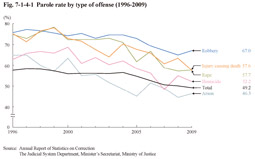Section 4 Probation/Parole Supervision
1 Parole
(1) Parole rate
Fig. 7-1-4-1 shows the parole rate for serious offenses in and after 1996. That for injury causing death, robbery, and rape remained at a high level when compared to that of all released inmates, while that for homicide has also generally remained at a somewhat high level. The parole rate has been on a declining trend for all these offenses.
Fig. 7-1-4-1 Parole rate by type of offense (1996-2009)
(2) Parole supervision period
Fig. 7-1-4-2 shows the percent distribution of parolees for serious offenses in 2009 and those in 1999-2008 (cumulative total) by parole supervision period. The proportion of parolees for serious offenses with the parole supervision period being for over six months and that for over one year was remarkably high, with their parole supervision period generally being longer than that of all parolees, which is probably due to the period of sentence for serious offenses being relatively long. Unlike all parolees, however, with every serious offense the percentage of parolees in 2009 with the parole supervision period being for over six months and for over one year was remarkably lower when compared to that of parolees in 1999-2008, thus indicating that the parole supervision period for serious offenses has been shorter in recent years.
Fig. 7-1-4-2 Percent distribution of parolees by parole supervision period and type of offense (2009, cumulative total of 1999-2008)

